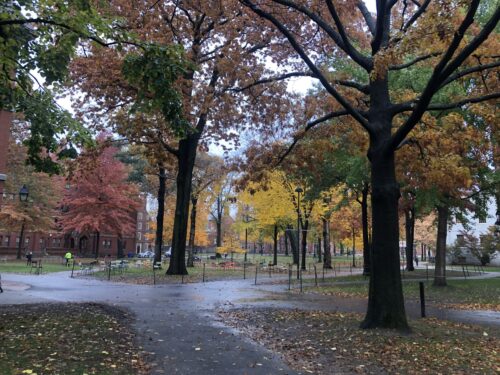This piece was originally part of a Harvard Independent themed series responding to, “How do you believe that the spirit and integrity of a Harvard College education can be best preserved in the upcoming fall semester?” Responses were collected prior to the July 6 announcement that the college would be adopting a virtual education model.
Essential to the Harvard College education is serendipity: the chance encounter that changes your interests, your friendships, your passion, your life.
Essential too are pheromones and hormones, because they tell us forcefully what we desire and whether we have found it.
Essential three is freedom of curiosity: the ability to take a flyer on a topic that struck a passing fancy, join the Indy and write what you care about, or talk our way into a graduate-level seminar having none of the prerequisites.
These essentials cannot be replicated via a virtual curriculum. Virtual courses are intentional (we have to know an email address and password), curated (the curriculum is designed and managed by another), and chaperoned (the eyes are watching and presumably recording for eternity). The inherent technological and interpersonal tensions between spontaneity and curation cannot be Zoomed away. I’ve taught Executive Education both in-person and virtually, and while virtual can be a quality information-educational experience, it is simply less spontaneous, less personal, less intimate, and plain and simply less fun for all concerned.
No matter how much virtual learning will be improved in the coming months, it is a lesser experience than in-person. Students know this. Harvard’s administrative corps knows it but cannot admit it, so Harvard is preparing the tuition battle space by floating three different strategies: 6,600 on-campus, 2,200, or 600. But though the College can blast out emails until it’s crimson in the face, those e-screeds won’t change the reality: two of these three options are lesser experiences.
All students are equal, says the College, but some will be more equal than others.
If only some come back, who will come back, and who will choose who comes back? In a purely private market scenario, those who can afford it most will be those who return, and that will widen the experiential and opportunity gap between richer and poorer Harvard students. On the other hand, if the college chooses, by what rules, what process, what transparency? Strings that are invisible can still be pulled.
Great is the irony: in a time when Harvard is preaching about reducing inequality, the college is actively promoting equality for me (in tuition) but not for thee (in the educational experience).
Decades ago, I learned a principle that’s served me well in business: Share the misery. Cut tuition for everybody, while preserving financial aid at pre-COVID levels. If fewer than all students may be on campus at the same time, rotate it in overlapping waves, including intra-semester rotations so that each on-campus cohort overlaps with at least two others (think dominos stacked at a slant). Emphasize first-years among those who get the earlier on-campus experiences, and apply the rotation equally thereafter. Anything else could well smack of elitism, self-interestedness, and hypocrisy.
David Smith ’75 was a former Indy Sports Editor.
Photo: Marissa Garcia ’21.

